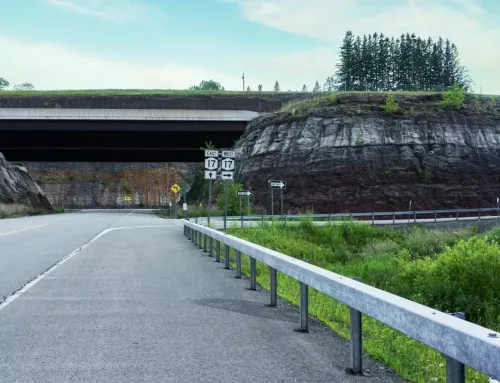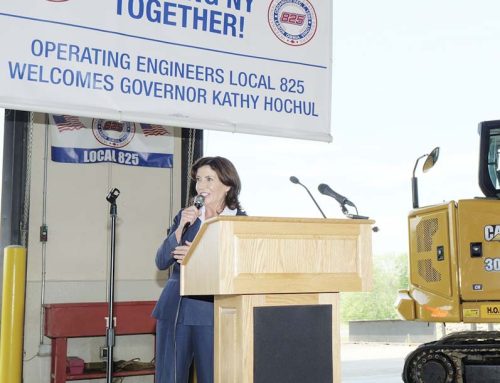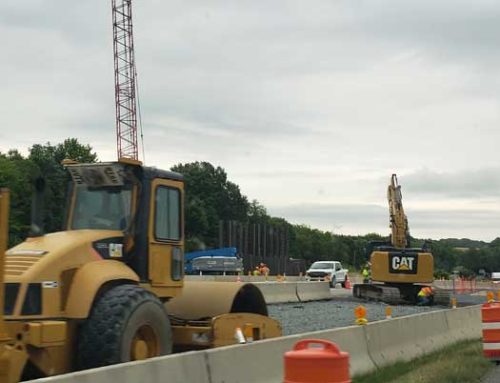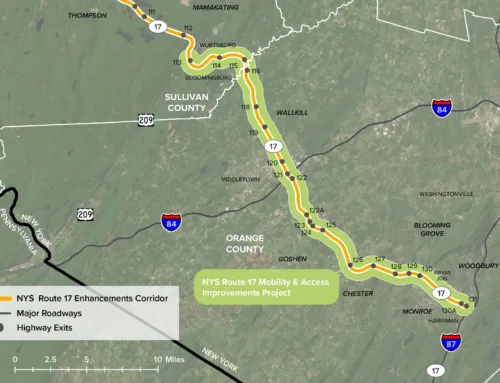
By Judy Rife
The 17 Forward 86 coalition wants it all: the conversion of Route 17 to a six-lane highway and to Interstate 86.
And Marc Baez thinks the coalition can convince the state that it should have it all.
“I think we can do it,″ said Baez, president and CEO of the Sullivan County Partnership for Economic Development. “The amount of money we’re talking about is peanuts in terms of the return that we’ll get on the investment — which makes it a good deal for the state as well as the region.”
The “peanuts” is the allocation of $500 million spread over the five years of the state Department of Transportation’s next capital plan to add a third lane in both directions to Route 17 from Harriman to Liberty. (The 2015-2020 capital plan is $29 billion.)
The DOT, which has been besieged for years on this very subject, responded that a third lane “remains under consideration.”
As far back as 2003, then-Gov. George Pataki’s DOT commissioner, the late Joseph Boardman, bluntly told an Orange County audience that the state wouldn’t consider adding a third lane until all 381 miles of Route 17 were converted to I-86.
“I know we have a problem on Route 17 now and I think part of the problem is land-use planning,″ said Boardman, adding local municipalities should think long and hard about the traffic implications of their policies and decisions.
Then-County Executive Edward Diana, now Wallkill town supervisor, fumed at Boardman after he finished: “I will not have Route 17 become a parking lot for Sullivan County (casinos).”
The coalition, however, believes this time is different because the development that had still only been wishful thinking as recently as 2013 when the DOT last assessed Route 17′s capacity has become a reality.
Sullivan County finally has a casino in Resorts World Catskills and an adjacent indoor water park in Kartrite Resort and Orange County soon will have Legoland New York — in addition to dozens of related and unrelated new businesses along the corridor.
“When the DOT did the last study, nobody had any idea what was coming and so nothing was done,″ said Baez. “And now that we do, the economic development community decided to dive in and get some energy behind that study and move it forward.”
First the Sullivan Partnership, the Orange County Partnership and the Orange County Citizens Foundation prodded state legislators to put $5 million in the DOT’s 2018-2019 budget to revisit the capacity study. Then, with the advice of a transportation consultant, they sought a series of meetings with the DOT.
And now, they’ve corralled like-minded leaders in business, labor and government to join them in campaigning for funding. The first of what the coalition promises will be many rallies was held in Albany on March 6.
“We’re going to beat the drum until we get the money in there,″ said Baez.
The DOT will advertise for consulting services for the new study this spring. Its parameters are still being defined but Baez said the coalition has been assured that it will review the conclusions of the earlier one regarding a third lane as well as advance improvements to Route 17 in general.
The 2013 study, forced on the DOT by a $1 million check from U.S. Sen. Chuck Schumer, found that projected traffic volumes through 2045 supported the construction of a third lane from the New York State Thruway to I-84 but no farther unless or until traffic volumes changed.
The projections, however, did not — could not — assess what actual travel patterns would be if and when a casino or other significant development occurred, beyond the assumption that commuters and tourists would not be traveling at the same time or in the same direction.
The Friday night/Sunday night crush on Route 17, a common phenomenon on the Thruway and other major highways, has never been enough to move the DOT’s needle.
Regardless, the study implicitly acknowledged that Orange County’s continued population growth in and of itself would eventually create the kind of daily recurring traffic congestion that warranted action.
The U.S. Census estimated Orange County’s population at 382,226 in 2017, a 2.5 percent increase — 9,413 people — over 2010, a pace that keeps it among the fastest-growing counties in the state.
Sullivan County, and the other eight counties in the Route 17/I-86 corridor, have lost population since 2010. The decline in Sullivan has been 2.7 percent — or 2,062 people — to 75,485.
The loss of population, ironically, is an argument for continuing to invest in Route 17′s conversion to I-86, a project that the state has been committed to since its conception 20 years ago as an economic development tool for the Southern Tier.
The coalition is confident the new study will validate its position on need but whether that alone is sufficient to propel the third lane into the capital plan and construction is an open question when costs and scope — particularly environmental impact studies — have yet to be determined.
The stickiest wicket, beyond noise and air quality, Orange County Planning Commissioner David Church said, will be assessing what is known as induced growth, a common impact of transportation projects that increase capacity.
Maureen Halahan, president and CEO of the Orange County Partnership, pointed out at the coalition’s rally that traffic congestion is the primary driver of local opposition to development in the Route 17 corridor.
But it does not necessarily follow that local people will embrace a third lane to ease that congestion if it encourages more development.
“I’m not naïve enough to think that we’re not going to have six lanes of traffic instead of four when they widen Route 17, but I think we need it,″ said Orange County Executive Steve Neuhaus before Legoland was a sure bet.
In a recent email, Neuhaus said he hasn’t changed his mind: “The entire corridor is growing and will continue to grow. It’s not a case of build it and they will come; it’s here so it’s time to play catch up.”
But the county, Church said, still wants to see attention paid to issues that weren’t addressed in the first study — namely improvements to the local road network that would allow local people to avoid Route 17 and to transit services, especially now that Legoland has emerged as an advocate for a local bus service that its employees could use.
“There have always been any number of interim measures, in the corridor and adjacent to it, that could be done relatively quickly and inexpensively to reduce congestion,″ said Church.
The capacity study estimated construction of a third lane for the 22 miles between Woodbury and Wallkill would cost $291 million in 2013 dollars. The coalition has increased the estimate, based on its conversations with the DOT, to $500 million to cover the 33-mile extension to Liberty.
The third lane’s winning card has always been that it could be added almost entirely within the DOT’s existing rights-of-way in the median and on the shoulders, skirting expensive and contentious property acquisitions on either side of the highway.
The study also recommended a host of improvements ranging from a collective $55 million to $650 million in the two counties to address safety and operational issues as well as accommodate present and future development.
Many of the measures — extending acceleration and deceleration lanes, closing and/or reconfiguring exits, raising bridge clearances, widening shoulders, for example — would simultaneously advance the conversion to I-86.
Baez said he expects the DOT would include some conversion work as a matter of economy in building a third lane to interstate standards but sees the two projects as complementing each other rather than competing for the same pot of money. Marrying the two, however, could affect pricetags and timelines.
“The Southern Tier probably thinks it’s about damn time somebody down here did something,″ said Baez.
Ted Bennett, the retired 40-year Chemung County legislator who kept the Southern Tier on message with the I-86 Coalition, praised 17 Forward 86 organizers for taking a page from their neighbors’ book.
“We had the west but we never really got the east,″ said Bennett. “So anything they do is only going to benefit all of us.”
Baez and Bennett have the same about time reaction to the $150 million reconfiguration of the Route 17 interchange at Exit 131 in Central Valley, the gateway to the Catskills and the Southern Tier from the Thruway — and Woodbury Common Premium Outlets.
The project, Orange County’s top priority for years, will be I-86 and third-lane ready when the DOT completes it this year — and the most notable of the 2013 study’s recommendations to advance to construction.
Neuhaus and Church predicted the new interchange, coupled with the Thruway’s switch to all-electronic tolling at Harriman will improve the traffic flow on Route 17 significantly.
“Sooner or later, at some point, the state’s got to start on the third lane,″ said Baez. “I think it should be now but it’s just as important at any time.”





